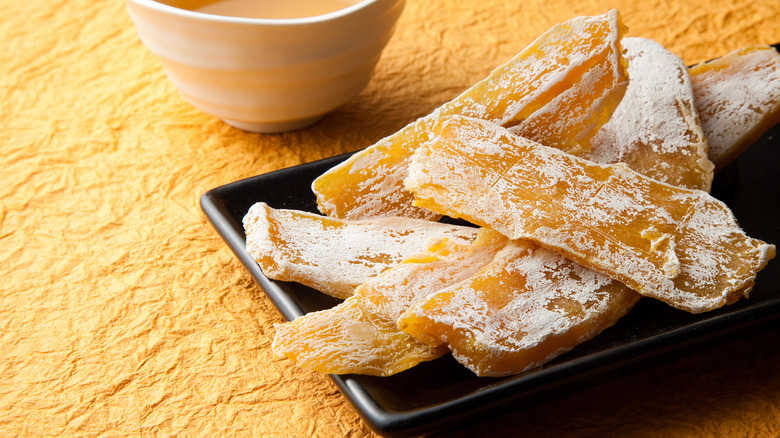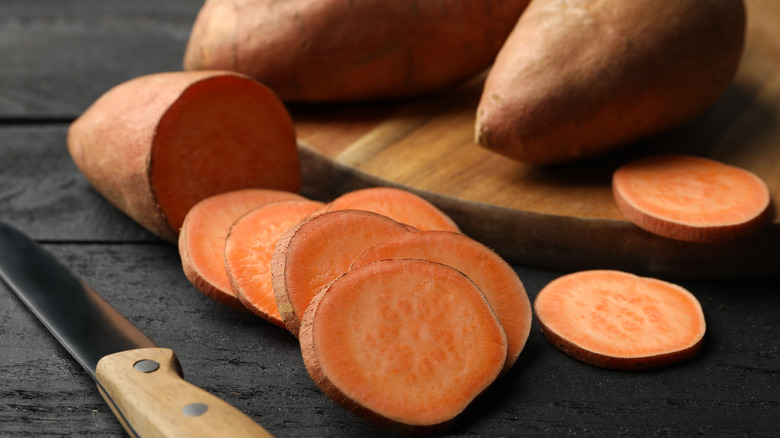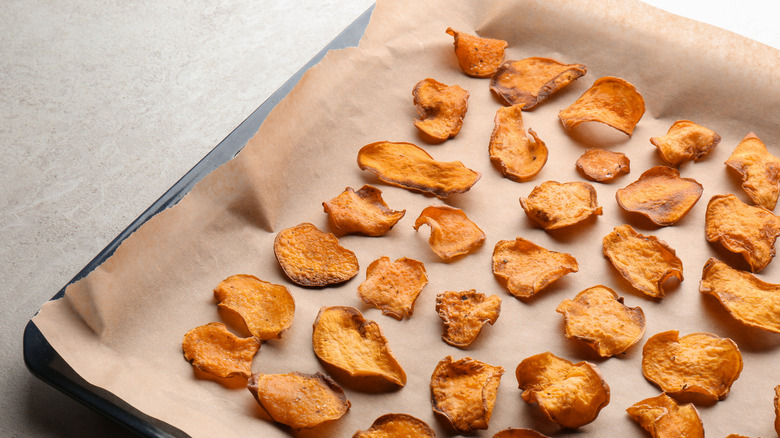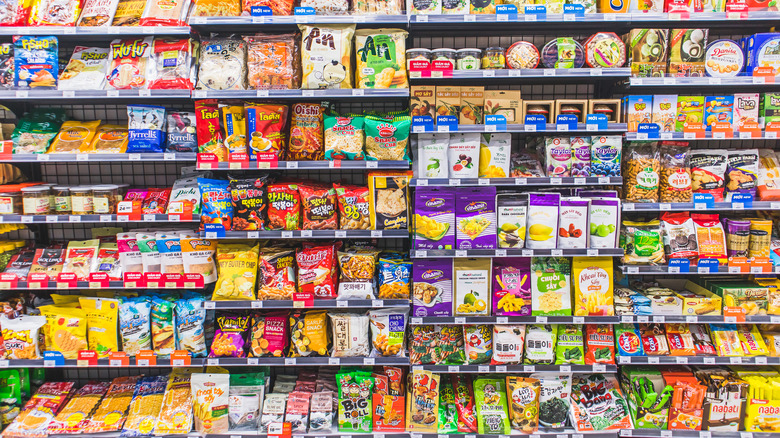Goguma Mallaengi: The Chewy Korean Sweet Potato Snack
We may receive a commission on purchases made from links.
You've all heard it before: "Dried fruits are nature's gummy candies." But, even though they're sweet, chewy, and much richer in fiber, vitamins, and minerals than traditional candy (via Healthline), no matter how much you try to convince yourself, they don't always satisfy your taste buds as a classic Sour Patch watermelon would. However, what if you've had it all wrong? Maybe nature's gummy candy isn't fruit at all — and the real golden gummy alternative is found in dried root veggies.
If you've ever spent time in the candy aisles of Korean food stores, you may have been let in on this secret. As you explored the aisles, you may have stumbled across colorful snack-sized packages, adorably adorned like any other candy item, of goguma mallaengi, otherwise known as dried Korean sweet potatoes. According to Korean Bapsang, this sweet treat is especially prevalent in Jeju Island, Korea, where it is a "major agricultural product." This candy especially appeals to gummy candy lovers and, obviously, sweet potato fans.
How goguma mallaengi is made
Goguma mallaengi means "dried sweet potato" in Korean, which provides a simplified yet accurate explanation of how the treat is made (via Maangchi). After baking or steaming the sweet potatoes, the cooked root veggies are left to cool, and their skin is removed. Once they're peeled, the potatoes are cut into small, bite-sized pieces — they can either be cut into rounds or small french-fry pieces — and placed inside of a dehydrator.
Depending on how moist the potatoes are, they can be left inside of the dehydrator for anywhere from 12 to 16 hours at a time — flipping halfway between (via Korean Bapsang). Not only does Bon Appetit say that the roasting and steaming steps enhance the potatoes' sweetness, but the slow and low dehydration method concentrates their flavor and dusts them with a sweet powder that is released from the potatoes' starches (the same thing as the sweet potatoes' white ooze you sometimes see when baking them). Looks-wise, the result is a combination of something between a powdered donut, french-fry, and Turkish Delight, with a texture that's both fudgy and stretchy like taffy.
Nutrition of goguma mallaengi
Calling goguma mallaengi "nature's candy" can be a tad misleading, seeing as Korean Bapsang and Maangchi's recipes have no added sugars or food coloring. Not to mention, as if it hasn't been made clear yet, the treats are made from sweet potatoes — a root vegetable that comes in colors from white and orange to purple and red, and is known for its bounty of health benefits.
According to WebMD, one sweet potato provides more than 25 grams of carbohydrates, two grams of protein, and nearly four grams of fiber. They're also packed with many essential vitamins and minerals, along with antioxidants called carotenoids that protect your cells from damage.
However, the dehydrating process that goguma mallaengi undergoes comes with some nutritional pros and cons. For instance, the University of Missouri says that dehydrating foods causes them to lose vitamins A and C and produce more calories. Harvard Health Publishing also notes that because dried snacks are smaller, it can be easy to eat too many in one sitting. Some may look at the smaller size of the snack as a positive, though, because they're ideal for on-the-go snacking while hiking or exercising.
Varieties of goguma mallaengi and where to find them
If you're not making your goguma mallaengi at home, there are a range of different brands you can find. You'll surely be able to find a selection of them in the candy or snack food aisle at your local Korean or Asian food market, and a quick Google search shows hundreds of shopping results. Food sites like Yami sell all kinds of Asian snack foods, including bags of dried sweet potatoes from brands like Yammy, Syz, and Qiao Zing Yuan. However, Justine Lee from Bon Appetit recommends a specific goguma mallaengi from a brand called JeollaNamdo that comes right from South Korea to your door, and can be purchased in a four-pack via Amazon.
When shopping for goguma mallaengi, you can find them in different shapes — from fry-like spears to rounds, and some that look similar to dried mango slices. You'll need to bite into different ones to determine which you prefer. Additionally, you should check the nutrition labels and ingredient lists to determine whether or not the specific product contains any added sugar because, ultimately, this could alter the nutritional value of the product as well as its taste. Because most of these products aren't readily available in the US, they can come at a price. So, if you have a food dehydrator at home, save yourself some money by making them yourself.



